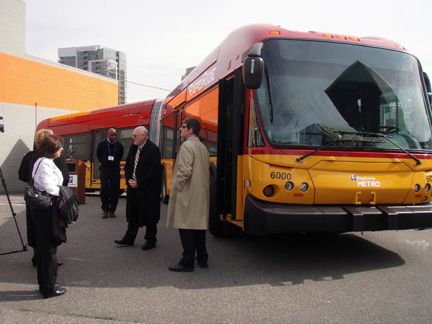
(WSB photos by Jonathan Stumpf)
Metro showed off its first RapidRide bus this morning – the type that will be serving West Seattle in two years — and announced new federal funding. Here’s the shelter prototype that also was shown off:

And here’s County Executive Ron Sims at the podium, in one of his last appearances before leaving that job, photographed along with two of the candidates to succeed him (County Council Chair Dow Constantine at left, County Councilmember Larry Phillips at right, inbetween them is County Councilmember Julia Patterson):

(edited 2:50 pm) Jonathan Stumpf was there for WSB; he took the photos you see, and also reports:
County Executive Ron Sims, County Council Members Larry Phillips and Dow Constantine, and various other transit and federal officials were on hand at 6th and Lenora Avenues as King County Metro displayed prototypes of RapidRide’s new hybrid diesel-electric bus, shelter and fare station.
The 60-foot, three-door bus will provide seating for 48 passengers, LED-displays with upcoming stop information, wi-fi and pay-as-you-board fare collection, with some pre-pay options available at certain stations. County Executive Sims called it a bus people will want to get on, a good day for the suburbs and said that people can now throw away the bus schedule, referring to frequency the busses will run. Metro Transit anticipates them running every 10 minutes during peak commute hours and every 15 minutes during non-peak hours.
Bus shelters will include passenger-activated lights to signal the bus, interior shelter lighting, bike racks and real-time information signs displaying the number of minutes until the next bus arrives.
Funding for this project is estimated at about $180 million. It is a combination of the Transit Now sales tax revenue, partnerships with cities and support from state and federal grants. The Federal Transit Administration announced today that it is releasing $14 million in new federal grant money to help fund the acquisition of the new black, red and yellow bus fleet.
As we noted earlier, we also have the county’s detailed news release about today’s announcement/display has just come in; read on for that:
As King County Metro Transit grapples with one of the worst revenue shortfalls in its history, the arrival of nearly $14 million in new federal grant money couldn’t have come at a better time. That funding, announced today by the Federal Transit Administration (FTA), comes as Metro prepares to road test the latest addition to its fleet – a cost-effective state-of-the-art hybrid bus that will move Metro’s new “RapidRide” service one step closer to reality.
On day two of a major national public transportation conference being held in Seattle, acting FTA Administrator Matt Welbes announced his agency is immediately releasing $13.8 million dollars to help fund the acquisition of new articulated hybrid-electric coaches and other system improvements to support Metro’s first RapidRide line. The funding will help pay for 16 new buses, various station and shelter enhancements and real-time information systems for the “A Line” serving the cities of Tukwila, Sea Tac, Des Moines, Kent and Federal Way beginning in 2010.
“The release of federal funding and arrival of this new coach will help
Metro deliver on its promise of offering more frequent, all-day bus
rapid transit (BRT) service on five of the county’s busiest transit
corridors as part of its “Transit Now” program,” King County Executive
Ron Sims said. “While a steep decline in operating revenues threatens
many Metro programs and services by 2010, RapidRide remains a solid
investment that must be preserved in order to serve some of the most
densely populated high ridership areas in our county.”Sims, transit officials and county councilmembers got their first look
today at the prototype bus about to become the workhorse of Metro’s new
RapidRide service. Its look is distinctively different from others in
the transit fleet. The sleek red and yellow coach is equipped with three
doors to speed boarding, 48 seats, a roomy interior and hybrid-electric
engine that delivers fuel economy and reduced emissions. Also unveiled
today was a prototype of the new shelter design that will further
distinguish Metro’s future BRT corridors.The RapidRide prototype is the first of 100 buses, manufactured by New
Flyer of America, scheduled to arrive over the next few years. The
buses are designed to be both efficient to operate and convenient for
passengers.In fact, efficiency is a key element of RapidRide as Metro struggles to
cope with shrinking revenues. Early BRT investments along Aurora Avenue
North have been successful in providing more frequent service to large
numbers of transit riders at a highly efficient cost. Everything about
RapidRide – the buses, the stops, the way it operates – is being
designed to keep people moving quickly and comfortably in heavily used
transit corridors.In the coming months, Metro will give its first RapidRide coach a full
workout. It will be put through a full battery of road tests to simulate
a variety of conditions, including full passenger loads on some of the
county’s most challenging counterbalances, hills and curves. The first
16 buses will be deployed on the “A” Line serving Tukwila to Federal Way
via Pacific Highway South beginning in mid-2010. Additional Metro
RapidRide corridors will include:* Bellevue to Redmond on NE Eighth Street and 156th Avenue NE via
Crossroads and Overlake (2011)
* West Seattle to downtown Seattle using Fauntleroy Way SW,
California Avenue SW, and State Route 99 (2011)
* Ballard to Uptown and downtown Seattle along 15th Avenue NW
(2012)
* Aurora Avenue N (State Route 99) between Shoreline and downtown
Seattle (2013)As Metro continues to develop its RapidRide service, it hopes new
transit financing tools approved during the past legislative session
will help it avoid cutting other vital transit services.“When our economy emerges from recession, we must have the necessary
transit improvements in place to meet the travel demands of a new
decade,” Sims said. “That means making smart decisions now so Metro can
continue to build on the work has already started.”

| 29 COMMENTS